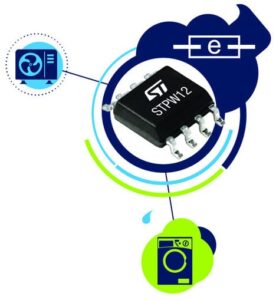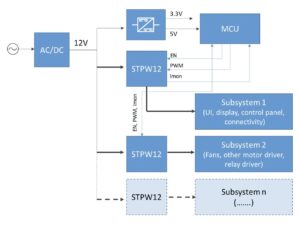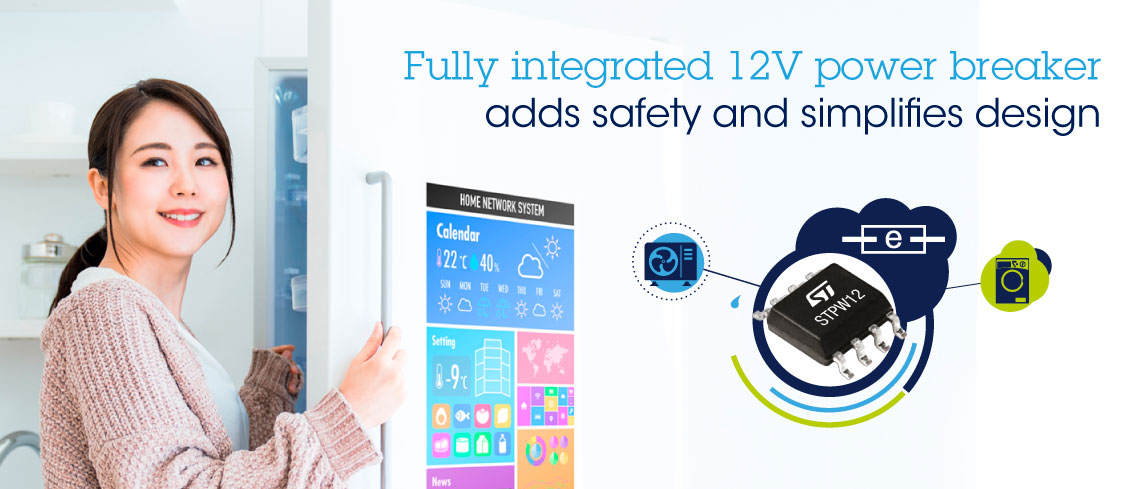The STPW12 is an electronic power breaker that connects in series to the 12 V DC rail and disconnects the load if the power exceeds a certain threshold that engineers define according to their application. Its performance far outweighs those of fuses or power switches to enable the creation of new products that must meet ever more stringent regulations. By using our new component, power management is a lot tighter, and manufacturers no longer need to spend as much money on isolating material for their wires since the STPW12 prevents overheating. Our teams also made the component smart by integrating an auto-retry feature, which means that even if a cost-effective system doesn’t have a microcontroller, our feature-rich power breaker can help designers take advantage of this feature.
The STPW12 is the fruit of requests from manufacturers that needed to meet new requirements for their low-power certifications, and that turned to our engineers for a solution that would simplify their design and make them more robust. One example is the IEC/UL 60730 standard by the International Electrotechnical Commission, which demands that the low-power loads embedded in household appliances not exceed 15 W. Additionally, consumers increasingly focus on the environment and their electricity bill, while also demanding innovative and smart experiences from their white goods, which means that the use of electronic control boards and complex user interfaces is ever more pervasive.
As a result, it is increasingly important to find solutions that keep the power consumption of each subsystem in check, prevent overloads, and allow companies to save money on isolation and wiring. Unfortunately, fuses and discrete overcurrent protections are not precise enough, and engineers had to implement elaborate mechanisms to stay within the power limit. Thanks to our new part, this is a problem of the past.
A Powerful Power Breaker With 3 % Accuracy and Self-Protection

One of the main reasons the STPW12 is unique within the industry is because it can sense power with a margin of error of only 3 %, which is far more accurate than similar solutions on the market today. Traditionally, we find this level of precision on high-quality electronic fuses, but they can only sense the current. However, it is possible for a faulty load to have a stable current, but a bad voltage, which implies that manufacturers looking stay under 15 W must use something else.
There are also systems that use on current-sensing amplifiers with voltage supervisors or hot-swap controllers and MOSFET switches, but even the best designs typically only offer a 10 % accuracy on top of being quite complex, space-consuming, and expensive. Hence, the power limiting solution becomes a burden and complicates the certification flow. Our new part is unique because it provides new levels of performance at a particularly interesting price point and requires low design efforts.
The STPW12 also has an RDS(on) of only 50 mΩ, which is a particularly low resistance for such an integrated solution. Furthermore, the device includes a short-circuit current limiter as well as a thermal shutdown feature to protect itself against extreme situations. Its operating junction temperature range is between -40 ºC and +125 ºC and protecting the device against an overload increases the robustness of the STPW12 as well as the rest of the PCB since these preventive measures also disconnect the load. As a result, manufacturers benefit from a power breaker that safeguards all their subsystems against a faulty load, which makes the new device reliable and smart.
A Great Power Breaker with Additional Features for a Microcontroller

Engineers can use the power breaker with a microcontroller in control units designed to monitor the power consumption of multiple subsystems, by reading the power monitor on the Monitor/Fault pin and use this information to implement complex algorithms as well as to adapt the load configuration. It not only simplifies the development of control features but enhances the reliability and safety of overall operations. However, an aspect of the STPW12 that could potentially be overlooked is that it is also self-sufficient, meaning that it doesn’t necessarily require a microcontroller. For instance, engineers can set the power threshold by connecting a specific resistor to the Rset pin and ground.
A Smart Power Breaker with Hardware Auto-Retry and Masking Time
Similarly, it is possible to enjoy the auto-retry feature by merely installing a specific capacitor. For instance, for a delay of one second, engineers will need to use a component with a capacitance of 70 nF, knowing that a lower capacitance means a shorter delay. In many cases, a bad load isn’t permanent. Hence, by implementing an auto-retry feature within the power device itself, the appliance can restart and potentially resume operations without the need of a more complex microcontroller, thus enabling manufacturers to offer more features at a lower cost.
The STPW12 also offers a PWM (pulse-width modulation) mode with programmable masking time. Engineers can quickly turn the internal switch on or off thanks to the PWM pin, which helps modulate the energy flowing to the load. When using the PWM mode a programmable masking time keeps the power limit protection inactive for a short delay that teams can define using an external resistor. For instance, a resistance on the Rdelay pin of 23.2 kΩ will enable a masking time of one millisecond. When controlling reactive loads, the in-rush current could result in a false positive and trigger the overpower protection, preventing startup. It is thus crucial to set a masking time in hardware to bypass that problem without requiring an external MCU.
- See all the features of the STPW12
